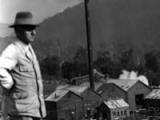An almost abandoned gold mining town, 38 km south-east of Reefton. Waiuta grew up to provide accommodation for miners who worked at the nearby Blackwater mine. A gold-bearing quartz reef was discovered by a prospecting party in 1905, and acquired by Consolidated Goldfields who developed the mine. From 1908 to 1951 this mine steadily produced gold from a steep, narrow quartz reef, providing 36% of the gold produced from the Reefton area. The town is now designated a protected area, under the care of the Department of Conservation, the few local residents and a volunteer society, the Friends of Waiuta.
Waiuta
Articles
Waiuta

Today Waiuta is a West Coast ghost town. But from 1906 to 1951 it was the company town for the South Island's largest gold mine and home to 600 people. The superb photographs of Czech immigrant Joseph Divis provide a fascinating glimpse of Waiuta in its heyday. Read the full article
Page 1 - Waiuta through the eyes of a miner
Today Waiuta is a West Coast ghost town. But from 1906 to 1951 it was the company town for the South Island's largest gold mine and home to 600 people. The superb photographs of
Page 2 - The Blackwater mine
A small prospecting group discovered a gold-bearing quartz reef in the upper reaches of Blackwater Creek, a tributary of the Grey River, on 9 November
Page 3 - The town of Waiuta
As more houses were built, Waiuta started to look less like a mining camp. It always had the appearance, though, of a frontier town dominated by wood and corrugated
Page 4 - From boom to bust
The outbreak of the Second World War led to a gradual decline in the number of
Page 5 - Joseph Divis, Waiuta's photographer
Biography of Waiuta photographer Joseph


























